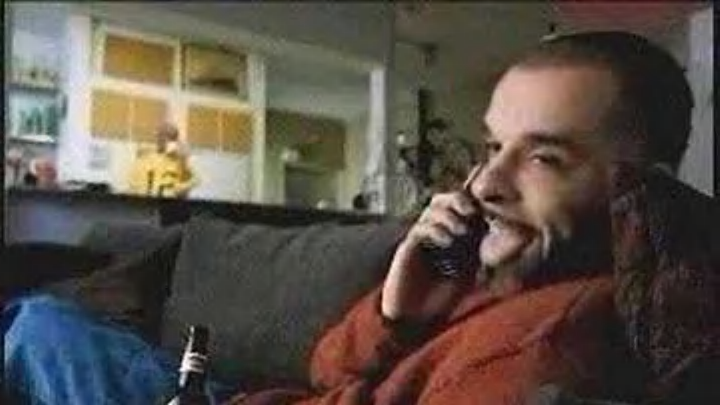On January 30, 2000, the Super Bowl aired a Budweiser ad that would embed itself into the brains of millions of Americans. A quarter of a century later, calling “Wassup?” into a crowded room will likely elicit echoes from anyone who lived through the cultural phenomenon. Despite its popularity, though, the origins of the advertisement aren’t widely known—and some might be surprised to discover that one of the most iconic beer commercials of all time actually didn’t start out as advertising at all.
A Short Film With Long Legs
In the late 1990s, then-music video director Charles Stone III released a short film called “True.” The two-minute scene features the director and his Philadelphia-area friends gag-greeting each other with open-mouthed, tongue-wagging “Wassups.” Vinny Warren, associate creative director at DDB Chicago (the agency that worked on the ad) came across the short when he was looking for ideas to pitch to Budweiser to run during playoff football and the Super Bowl. He thought that Stone’s storyline, gags, and aesthetic could easily translate to commercials. Beyond that, Warren sensed the concept’s viral potential, telling the Taplines podcast that everyone he showed the clip to couldn’t help saying “Wassup,” and that “everybody in America might have this reaction to this film.”
Don Pogany, the agency’s group creative director, told The New York Times that Warren “recognized right away that it could be a Bud spot,” saying, “it didn’t feel like advertising. It seemed different than anything else. And it seemed to be totally what Bud is about: camaraderie and friendship and what guys do. It was a way to illustrate male bonding in a simple fresh way.”
Superbowl Sensation
Fortunately for Warren and DDB, Stone—and eventually Budweiser—agreed and set about producing the ad that would come to be called “Wassup?” Though “True” featured Stone’s actual friends—Fred Thomas, Paul Williams, Terry Williams, Jimmy “Puerto Rock” Perez, and Kevin Lofton—Anheuser-Busch (A-B) and DDB wanted to cast a wider net when looking for talent. They auditioned about 80 people before deciding to just go with Stone’s original friends—save Lofton, who turned down the opportunity and was replaced by Scott Martin Brooks. Budweiser reportedly saw the all-Black cast as key to helping the brand carve out more of a name for itself in the “urban” marketplace, which is undoubtedly why the brand also hired Stone to direct not just “Wassup?” but also a series of follow-ups.
The first “Wassup?” spot received little attention when it debuted on Christmas Day 1999. Nonetheless, Anheuser-Busch took a chance and picked “Wassup?” to run during the Super Bowl in one of its mid-game ad slots. It aired after halftime, during the height of what some consider to be one of the best Super Bowls of all time: The actual game ended when Rams linebacker Mike Jones tackled Titans wide receiver Kevin Dyson one yard short of the goal line, preventing a possibly game-winning touchdown. It’s remembered as one of the most famous plays in Super Bowl history—but even so, it didn’t overshadow the one-minute commercial, which was an instant sensation.
Late night television hosts started to say “Wassup,” as did disc jockeys and various media professionals. Recreations of the clip started to take off online, where the phrase became an early-internet meme. There were parodies of “Wassup?” featuring everyone from the South Park characters to Elián González to the DC SuperFriends. While some companies may have challenged the unauthorized usage of the catchphrase, A-B recognized it was only building its brand.
By March, “Wassup?” was such a hit that the ad’s cast had garnered a following. They were sent on a promotional tour by A-B, appearing at Budweiser-sponsored events like the World Series. By September, DDB estimated that “Wassup?” had generated an additional $20 million dollars in publicity for Budweiser, just by virtue of how often people were quoting the clip in television and print news reports. (The agency had no way of tracking internet publicity at the time, so that figure may have been higher.) That’s in addition to the actual sales bump Budweiser got following the ads, with trade publication Beer Marketer’s Insights reporting that A-B’s sales went up by an estimated 2.4 million barrels in the months following the initial “Wassup?” drop, to 99.2 million total for the year. That’s a lot of Buds.
The Legacy of a Word
“Wassup?” was so popular it yielded not just a string of sequels—like “Wassup Girlfriend,” “Wassup Grandmas,” and “Wassup Wasabi”—but also took home numerous accolades. It won a Cannes Grand Prix award and a Grand Clio. It’s been parodied in the Scary Movie franchise, rebooted for a pandemic-era ad about checking on your buds in lockdown, and even mimicked on the Today show’s Halloween spooktacular. Stone—who also released a pro-Obama parody of the clip called “Wassup 2008”—would ride the success of the ads to a career in Hollywood, directing movies like Drumline (2002) and Mr. 3000 (2004), as well as episodes of Friday Night Lights, Black-ish, and Superstore.
Decades later, the word wassup is still part of the American lexicon, thanks mostly to this one ad. Vinny Warren, the creative director who first brought “True” to his agency’s and Budweiser’s attention, says he’s never known for sure why the clip popped off. In 2019, he told Mel magazine that he definitely saw the ad hit home with “the generation of young (white) drinkers that had swallowed hip-hop culture whole,” noting that “Eminem had just hit. African-American culture was loved by everyone. White people in the Midwest were trying to sound like they were from Compton.” And everyone, it seemed, just loved to say “Wassup?”
Read More About Advertising:
